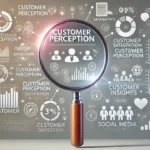Introduction
In today’s fast-paced digital world, the power of a well-designed logo is undeniable. A logo is more than just a graphic symbol; it’s the face of a brand, encapsulating its identity and values in a single, memorable image. As we delve into the fascinating world of the psychology of logo design, we unravel how these visual emblems make a lasting impression on consumers. This blog post aims to guide those new to digital marketing through the intricate process of designing a logo that not only looks appealing but also resonates emotionally with its audience. We will explore the impact of logo design on brand identity, how logos can evoke specific emotions, and the principles that underpin effective logo creation. Whether you’re a budding entrepreneur or a curious marketer, understanding the science and strategy behind creating memorable logos is crucial in establishing a strong and enduring brand presence.
Understanding the Psychology of Logo Design
The psychology of logo design is an intriguing aspect of branding that blends art and science. This concept revolves around the idea that a logo is not merely an artistic creation but a strategic tool capable of influencing consumer perception and behavior. At its core, the psychology behind logo design leverages human psychology to create a visual identity that resonates on a deeper, often subconscious level with the target audience.
For instance, the iconic Apple logo, with its bitten apple, is not just memorable but also symbolizes knowledge, innovation, and a hint of rebellion – traits closely associated with the brand. Similarly, the simplicity and boldness of the Nike swoosh convey motion and achievement, aligning perfectly with the brand’s ethos of athletic excellence.
Logos become powerful when they tap into universal symbols and archetypes that people instinctively understand. This understanding of logo symbolism helps brands connect more profoundly with their audience. By employing shapes, colors, and fonts strategically, designers can evoke specific emotions and associations. A circular logo, for example, might imply community and unity, while angular designs can suggest stability and efficiency.
Effective logo design, therefore, is not just about aesthetics; it’s about embedding a brand’s essence into a visual form that speaks directly to the viewer’s psyche, creating an indelible mark in their mind. Understanding this psychological interplay is crucial for anyone venturing into digital marketing and brand development.
The Impact of Logo Design on Brand Identity
Logo design is a pivotal element in shaping and communicating a brand’s identity. It serves as a visual shorthand, conveying the essence of a brand at a glance. The impact of logo design on brand identity is profound, as it often forms the first point of interaction between the brand and its potential customers. A well-designed logo not only captures attention but also imparts key aspects of a brand’s personality and values.
Take, for example, the golden arches of McDonald’s. This simple, yet distinctive logo is instantly recognizable around the world, embodying the brand’s commitment to quick service and consistent quality. It’s more than just a symbol; it’s a representation of the entire customer experience that McDonald’s offers. Similarly, Amazon’s logo, with its clever arrow pointing from A to Z, subtly communicates the brand’s extensive range of products and customer satisfaction.
In digital marketing, where first impressions are crucial, a logo can be a decisive factor in establishing brand recognition and loyalty. It’s not just about visual appeal; it’s about creating a symbol that encapsulates the brand’s story, values, and vision. An effective logo design, therefore, is integral to brand identity, acting as a foundation upon which customer relationships are built and nurtured. It’s a visual anchor that ties together all other aspects of a brand’s marketing strategy, ensuring consistency and recognition across various platforms.
Emotional Influence of Logos
The emotional influence of logos is a powerful tool in the arsenal of digital marketing. A well-crafted logo can evoke a range of emotions and feelings, which play a crucial role in how consumers perceive and interact with a brand. This emotional connection is key in creating memorable logos that foster brand loyalty and recognition.
Consider the heart-warming and familial emotions evoked by the Coca-Cola logo. Its classic script font and vibrant red color are not just visually appealing; they evoke feelings of happiness, nostalgia, and comfort. Similarly, the Twitter bird, with its upward trajectory and light, airy design, suggests freedom, communication, and the rapid spread of information, aligning perfectly with the platform’s essence.
The emotional influence of logos extends beyond mere recognition. It builds an emotional bridge between the brand and its consumers, making the brand more relatable and approachable. For instance, the playful and whimsical font of the Disney logo instantly transports audiences to a world of imagination and magic, resonating deeply with both children and adults.
In crafting logos, designers must consider the emotional impact of every element, from color and shape to typography. A successful logo not only stands out visually but also connects with the audience on an emotional level, creating a lasting impression that transcends the visual experience. This emotional resonance is what makes a logo truly powerful in the realm of brand identity and customer engagement.
Principles of Effective Logo Design
Effective logo design is governed by a set of principles that ensure a logo is not only aesthetically pleasing but also functional and relevant. Understanding these logo design principles is crucial for anyone venturing into the realm of digital marketing and brand development.
Simplicity: The best logos are often the simplest. A simple design makes a logo easy to recognize, versatile, and memorable. The Nike swoosh and the Apple logo are epitomes of simplicity, both instantly recognizable even without accompanying text.
Memorability: Alongside simplicity, a logo must be memorable. This is achieved through distinctive yet appropriate design elements that set it apart from competitors. The playful, whimsical font of the Disney logo, for example, is instantly memorable and evokes the brand’s essence.
Timelessness: An effective logo should stand the test of time. It should feel fresh and relevant for many years, avoiding trends that may become dated quickly. The Coca-Cola logo, for example, has remained largely unchanged for over a century, proving its timeless design.
Versatility: A great logo should work across various mediums and applications. It should be scalable, looking good on both a small business card and a large billboard. This requires thoughtful consideration of color, form, and detail.
Relevance: Finally, a logo must be appropriate for the business it represents. The color, shape, and font should align with the business’s industry, target audience, and brand identity. For instance, a law firm might opt for a strong, traditional typeface to convey professionalism and stability.
Adhering to these principles helps in creating effective logo design strategies that resonate with audiences and endure over time. They are the foundation upon which memorable and influential logos are built.
The Role of Color in Logo Design
Color plays a pivotal role in logo design, profoundly impacting a brand’s image and how it is perceived by consumers. The psychology of color in logos is an area of study that highlights how different hues can evoke specific emotions and associations, making it a crucial element in creating an effective brand identity.
Emotional Connections: Colors have the power to evoke emotions. For example, red can convey passion and energy, often used by brands like Coca-Cola and Red Bull to evoke excitement and boldness. In contrast, blue, used by Facebook and Twitter, is often associated with trust, dependability, and professionalism.
Brand Messaging: The choice of color in a logo can communicate a brand’s message and values. Green, used by companies like Starbucks and Whole Foods, is often associated with nature, health, and sustainability, aligning with their brand identities focused on natural and organic products.
Target Audience Appeal: Color choices can also appeal to specific demographics. Bright and vibrant colors may attract a younger audience, while more subdued tones might appeal to a more mature demographic. Understanding the target audience is key in selecting the appropriate color palette.
Differentiation and Recognition: In a crowded market, colors can help a logo stand out and be easily recognizable. For instance, the bright orange of Fanta or the distinctive purple of FedEx helps these brands stand out against competitors.
Cultural Considerations: It’s important to consider cultural differences in color perception. Colors can have different meanings in different cultures, which should be considered in global marketing strategies.
Incorporating color psychology in logos requires a careful balance between aesthetic appeal and functional effectiveness. The right color choice can enhance brand recognition, establish emotional connections with the audience, and communicate a brand’s core values and personality. Understanding the role of color in logo design is essential for creating a visual identity that resonates with consumers and supports the brand’s overall marketing objectives.
Brand Recognition and Its Ties to Logo Design
Brand recognition is the ability of consumers to identify a brand by its attributes, with the logo often being the most prominent. The design of a logo plays a crucial role in building and reinforcing this recognition. A well-crafted logo serves as a visual cue that embodies the brand’s essence and makes it easily distinguishable in a competitive marketplace.
A key aspect of achieving brand recognition through logo design is consistency. Brands like Apple, McDonald’s, and Nike have maintained consistent logo designs over the years, making them instantly recognizable worldwide. This consistency extends across all marketing materials, reinforcing the brand identity at every customer touchpoint.
The uniqueness of a logo also contributes significantly to brand recognition. A distinctive logo design can set a brand apart from its competitors and make it more memorable. For example, the Twitter bird or the Snapchat ghost are unique symbols that immediately bring the respective brands to mind.
Moreover, the effectiveness of a logo in building brand recognition is often seen in its adaptability. Logos that are versatile and scalable, easily applied across various mediums from digital platforms to physical merchandise, help maintain brand visibility and recognition.
In summary, the ties between logo design and brand recognition are foundational in the world of marketing. A well-designed logo not only captures the brand’s identity but also plays a vital role in making the brand recognizable, memorable, and distinguishable in the minds of consumers.
Current Trends in Logo Design
Staying abreast of current trends in logo design is crucial for brands looking to remain relevant and appealing in an ever-evolving digital landscape. These trends reflect changes in consumer preferences, technological advancements, and broader societal shifts. Here are some key logo design trends that have been shaping the branding world:
Minimalism: The trend towards minimalism continues to dominate, with brands opting for clean, uncluttered designs that are easily recognizable and scalable. This trend is evident in logos like Google’s, which uses simple typography and spacing for a clear and impactful design.
Responsive Logos: In the age of digital media, logos must adapt across different platforms and devices. Responsive logos that can be scaled or adjusted for various digital formats without losing their essence are becoming increasingly popular. This versatility ensures brand consistency across all user experiences.
Geometric Shapes: The use of geometric shapes in logos has gained traction, offering a sense of stability and balance. Squares, triangles, and circles can convey different messages and emotions, as seen in logos like Adobe’s and Microsoft’s.
Vintage and Retro Styles: Nostalgia plays a big role in current design trends, with many brands reverting to vintage or retro styles. This trend often evokes a sense of authenticity and heritage, appealing to emotions of nostalgia and familiarity.
Bold Typography: Strong, bold typography is a trend that emphasizes clarity and impact. Brands are choosing fonts that stand out and make a statement, reflecting confidence and strength.
These trends highlight the dynamic nature of logo design and underscore the importance of understanding current consumer preferences and technological capabilities. Adapting to these trends, while maintaining brand identity, is key to creating logos that are both modern and timeless.
Understanding Logo Symbolism
Logo symbolism is a critical aspect of logo design, where symbols are used to convey deeper meanings and narratives about a brand. This subtle yet powerful element of logo design can significantly enhance a brand’s message and connection with its audience.
Symbols in logos often represent the brand’s values, heritage, or unique selling propositions. For instance, the Amazon logo features a smile that goes from A to Z, symbolizing the company’s wide range of products and customer satisfaction. The arrow also suggests forward movement and efficiency. Similarly, the Twitter bird symbolizes freedom, speed, and the ability to communicate globally, aligning with the platform’s purpose.
Understanding and utilizing logo symbolism involves more than just visual appeal; it requires a deep understanding of the brand’s core values and the message it wants to convey. Symbols can be abstract or literal, but they must always be relevant and meaningful to the brand’s identity.
Moreover, cultural implications play a significant role in logo symbolism. A symbol that is positive in one culture might have a different connotation in another. Therefore, it’s crucial for designers to have a global perspective, especially for brands with an international presence.
In summary, understanding logo symbolism is key to designing logos that not only attract attention but also tell a brand’s story in a compelling and memorable way. This deeper level of connection between the brand and its consumers through symbolism is what makes a logo truly iconic and enduring.
Strategies for Making Logos Stand Out
In the crowded marketplace of today, making a logo stand out is crucial for brand visibility and recognition. Here are some effective strategies to ensure that a logo not only captures attention but also makes a lasting impression:
Unique Color Combinations: Utilizing unique or unconventional color combinations can make a logo pop. This doesn’t mean using loud colors; rather, it’s about finding a palette that differentiates the brand while still aligning with its personality. For instance, Spotify’s use of vibrant green sets it apart in the music industry.
Clever Use of Negative Space: Negative space, when used creatively, can add a layer of sophistication and intrigue to a logo. The FedEx logo, with an arrow hidden between the ‘E’ and ‘x’, is a classic example of using negative space ingeniously.
Dynamic Imagery: Logos that imply motion or change can be more engaging. This can be achieved through lines suggesting movement or through images that have a dynamic quality, like the Twitter bird appearing as if it’s in mid-flight.
Balancing Simplicity with Uniqueness: While simplicity is key, adding a unique twist to a simple design can make a logo stand out. The Apple logo is simple, but the bite out of the apple adds distinctiveness.
Emotional Appeal: Incorporating elements that connect emotionally with the target audience can make a logo more memorable. This could be through imagery, color, or typography that resonates with the brand’s user base.
By employing these strategies, logos can rise above the noise of competitors and create a visual identity that is not only distinctive but also meaningful and memorable. This involves not just creative design but also a deep understanding of the brand’s essence and its audience.
Conclusion
In the realm of digital marketing, the art of logo design is much more than creating a visually appealing symbol. It’s about weaving the essence of a brand into a design that resonates emotionally with consumers and stands the test of time. From understanding the psychology behind color choices to harnessing the power of symbolism, effective logo design is a multifaceted process. It plays a crucial role in brand identity, recognition, and consumer connection. As we’ve explored, combining these elements with current trends and effective strategies can result in a logo that not only captures attention but also embodies the brand’s story and values. For those new to digital marketing, mastering the art of logo design is a journey worth embarking on, opening doors to powerful branding and enduring business success.











